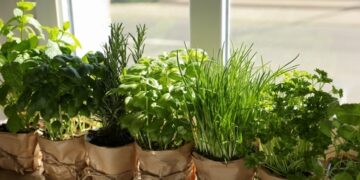Medicine in the Kitchen
Sometimes the most powerful remedies are already in your cupboard—tucked beside the olive oil or scattered on a cutting board, releasing their fragrant oils into the air as you prepare a meal. Culinary herbs are often overlooked as medicine, but in truth, they’ve been used for centuries not only to flavor food but to fortify the body, calm the mind, and aid digestion. They are, in many ways, the most accessible form of herbal medicine: familiar, comforting, and always close at hand.
Sage, thyme, rosemary, basil—these humble herbs hold within them a rich history of healing. Their essential oils, bitter compounds, and antioxidant properties offer a quiet strength that nourishes us with every bite. And the beauty is, you don’t need to be an herbalist to use them. You’re likely already using them—perhaps without even realizing the benefits.
Ad Spot #1
(Insert your first promotional element here.)
Thyme: Guardian of the Breath
Thyme is one of the oldest known medicinal herbs, revered for its strong antimicrobial properties and long-standing use in respiratory health. Its leaves are rich in thymol, a compound known to help fight off bacteria and viruses. In traditional kitchens and apothecaries alike, thyme was used to clear coughs, soothe sore throats, and warm the body during cold, damp weather.
In the kitchen, thyme brings brightness and depth to soups, stews, roasted vegetables, and meats. But it also makes a lovely herbal tea. A simple infusion of thyme, honey, and lemon can be a gentle support during cold and flu season—especially when the chest feels heavy or the throat grows scratchy.
Sage: Wisdom for the Mind and Body
Sage, with its silvery-green leaves and earthy scent, is a plant long associated with longevity and clarity. Traditionally used for sore throats, inflamed gums, and digestive discomfort, sage is cooling, astringent, and gently antibacterial. It’s particularly helpful for mouth and throat issues—an old remedy involves gargling with a sage infusion at the first sign of illness.
But sage is also known for its affinity with the nervous system. In times of mental fog, forgetfulness, or menopausal imbalance, sage can help clear the mind and regulate internal heat. Its role in memory support has even been noted across cultures—hence the name, perhaps.
Culinarily, sage pairs beautifully with root vegetables, beans, poultry, and creamy sauces. Just a few leaves can transform a simple dish into something deeply grounding and aromatic.
Rosemary: The Brightening Tonic
Rosmarinus, “dew of the sea,” is a herb of remembrance and resilience. With its sharp piney scent, rosemary stimulates both body and mind. It improves circulation, supports digestion, and has a mild stimulating effect that can lift foggy energy.
Rosemary has also been associated with heart health and cognitive function. It’s no wonder students in ancient Greece wore garlands of it while studying—it’s a plant that sharpens, strengthens, and stirs.
In the kitchen, rosemary is bold. Use it in roasted dishes, bread doughs, infused oils, or even in sweet applications like lemon-rosemary syrups or herbal honeys. A strong rosemary tea can also be used as a hair rinse to invigorate the scalp and promote growth.
Basil: Gentle Uplift
Sweet basil, fresh and aromatic, is more than a favorite in summer salads—it’s a gentle digestive and mood lifter. It has a calming, balancing effect on the nervous system and can ease bloating and mild nausea. In some traditions, basil is thought to protect the heart—not just physically, but emotionally.
Used fresh, it carries the peak of its vitality. Toss it into meals at the last moment, or blend it into teas with lemon balm or mint for a calming evening brew.
Oregano: The Fire-Keeper
Oregano is warming, stimulating, and strongly antimicrobial. It helps fight off infections—especially respiratory or digestive ones—and brings warmth to cold, sluggish systems. It’s particularly helpful for clearing sinuses and supporting the lungs, and its essential oil is sometimes used (with caution) for powerful immune support.
In food, oregano is bold and earthy. A classic in Mediterranean dishes, it adds richness to sauces, meats, and vegetables. During colder months, try a tea of oregano, thyme, and a little honey to open the chest and lift the fog of seasonal sluggishness.
Ad Spot #2
(Insert your second promotional element here.)
From the Stove to the Apothecary
What makes culinary herbs so special is their seamless integration into daily life. There’s no need for tincture bottles or fancy formulations (though those have their place). Every time you cook with sage, sprinkle thyme, or crush rosemary between your fingers, you’re practicing herbalism. You’re participating in an ancient act of nourishment and healing.
To deepen this relationship, try setting aside a small part of your weekly cooking time for intentional herbal preparation:
-
Herbal teas: Infuse fresh or dried kitchen herbs in hot water to sip throughout the day.
-
Infused oils: Add rosemary or oregano to olive oil, let steep in sunlight, and drizzle over meals.
-
Salt blends: Mix dried thyme, sage, or basil with sea salt for a mineral-rich seasoning.
-
Kitchen remedies: Make thyme-honey for coughs, sage vinegar for sore throats, or rosemary hair rinse for vitality.
Each of these is simple. None of them require a lab or a degree. They are small acts of care, rooted in daily life.
A Return to Everyday Healing
There is wisdom in the kitchen. Herbs that live on your counter or windowsill are more than flavor—they are medicine hiding in plain sight. They offer antimicrobial protection, digestive ease, cognitive clarity, and gentle emotional support. And they do it in the most accessible, welcoming way: in your soup, your tea, your garden, your hands.
By seeing kitchen herbs not just as seasonings but as allies, we invite healing into every meal. We remember that food can be sacred, that care can be simple, and that sometimes, the remedy has been right here all along.



























